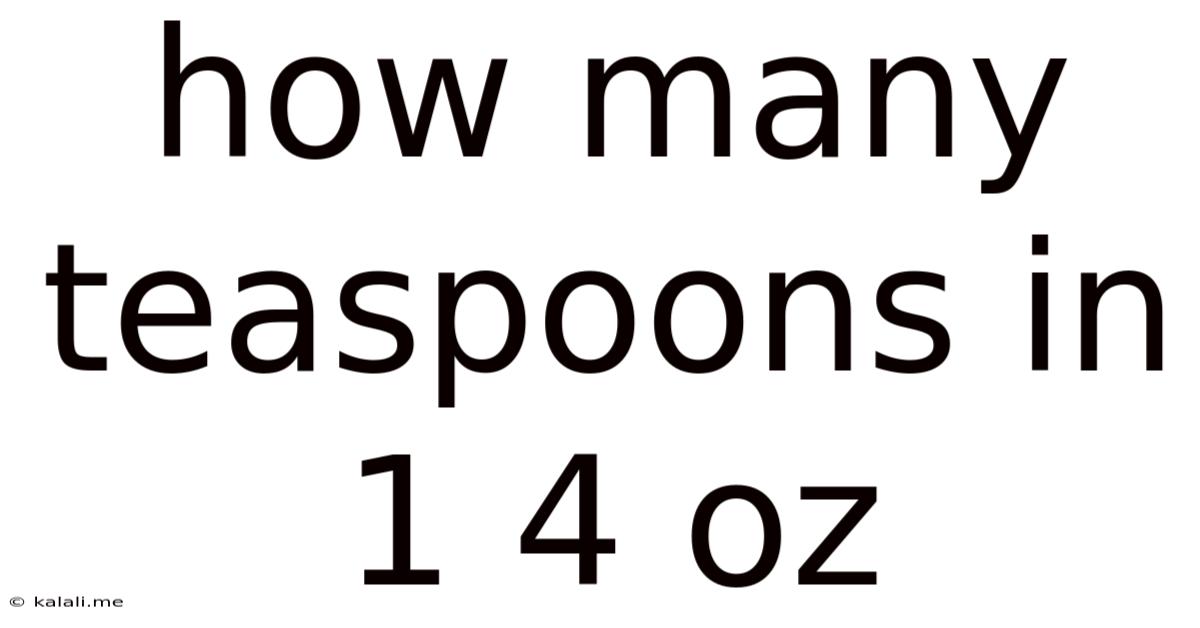How Many Teaspoons In 1 4 Oz
Kalali
Jul 26, 2025 · 4 min read

Table of Contents
Decoding the Teaspoon: A Comprehensive Guide to Understanding 4 oz in Teaspoons
How many teaspoons are in 1 4 oz? This seemingly simple question actually delves into the fascinating world of volume measurements, highlighting the nuances of converting between units and the importance of precision, particularly in cooking, baking, and medicine. This article will provide a thorough explanation, addressing common misconceptions and exploring the various factors that influence the final conversion. We’ll go beyond a simple numerical answer and provide you with the tools to confidently convert between ounces and teaspoons in any situation.
Understanding the Units: Ounces and Teaspoons
Before diving into the conversion, it’s crucial to understand the units involved. We're dealing with two different systems of measurement:
-
Ounces (oz): This is a unit of weight in the avoirdupois system, commonly used in the United States and other countries. It's important to remember that an ounce is a measure of weight, not volume. One fluid ounce (fl oz), on the other hand, is a unit of volume. This distinction is critical for accurate conversions. We often see “oz” used interchangeably with “fl oz” in everyday contexts, especially in recipes and food packaging. However, for precise conversions, we need to clarify whether we are referring to weight or volume.
-
Teaspoons (tsp): This is a unit of volume, commonly used in cooking and baking. A teaspoon is approximately 5 milliliters (mL). However, the exact volume can vary slightly depending on the utensil used.
The Conversion: How Many Teaspoons in 1 Fluid Ounce?
The key to accurate conversion lies in understanding that we need to use fluid ounces, not weight ounces. There are approximately 6 teaspoons in 1 fluid ounce (fl oz). This is a commonly used approximation, but the precise number can fluctuate slightly based on the measurement tools and their level of precision. Therefore, it is crucial to use standardized measuring tools for consistency, especially in culinary applications or medical contexts.
Factors Affecting the Conversion
Several factors can influence the accuracy of the conversion:
-
Type of liquid: The viscosity of the liquid can affect its volume. Thicker liquids like honey will occupy a slightly larger volume than thinner liquids like water for the same weight.
-
Measuring tools: Variations in the size and shape of teaspoons and measuring cups can lead to discrepancies. Using standardized measuring tools is crucial for consistency.
-
Temperature: The temperature of a liquid can affect its volume. Liquids generally expand when heated and contract when cooled.
-
Precision required: The level of precision required will dictate how meticulously the conversion needs to be performed. For everyday cooking, a rough approximation is often sufficient. However, in scientific or medical contexts, greater accuracy is essential.
Practical Applications and Examples
Let's look at some practical examples to illustrate how this conversion is used:
-
Cooking: A recipe calls for 2 fluid ounces of vanilla extract. To convert this to teaspoons, we multiply 2 fl oz by 6 tsp/fl oz, resulting in approximately 12 teaspoons.
-
Baking: A recipe requires 4 fluid ounces of milk. This is equivalent to approximately 24 teaspoons (4 fl oz * 6 tsp/fl oz).
-
Medicine: While teaspoons are sometimes used for measuring medicine, it's generally recommended to use a designated medication measuring device for greater accuracy and safety. The potential for dosage errors using household utensils is high, so relying on professionally calibrated devices is paramount.
Beyond the Basic Conversion: Exploring Related Conversions
Understanding the teaspoon to fluid ounce conversion is a stepping stone to other essential volume conversions:
-
Tablespoons (tbsp): There are approximately 3 teaspoons in 1 tablespoon. Therefore, you can also convert fluid ounces to tablespoons by first converting to teaspoons and then to tablespoons.
-
Milliliters (mL): One teaspoon is approximately 5 mL. This conversion can be helpful when using metric recipes or working with scientific measurements.
-
Cups: There are 8 fluid ounces in 1 cup. This is a standard conversion widely used in cooking and baking.
Addressing Common Misconceptions
A frequent source of confusion arises from the difference between weight ounces and fluid ounces. Remember:
-
Weight ounces (oz): Measure the mass or weight of a substance.
-
Fluid ounces (fl oz): Measure the volume of a liquid.
Confusing these two can lead to inaccurate measurements, especially in recipes involving ingredients with varying densities.
Conclusion: Mastering the Teaspoon Conversion
While the simple answer to "How many teaspoons are in 1 4 oz?" is approximately 24 teaspoons (considering 4 fluid ounces), understanding the nuances of the conversion is key. This includes understanding the difference between weight and fluid ounces, the factors that might influence the conversion’s accuracy, and the importance of using standardized measuring tools. This knowledge is vital for anyone involved in cooking, baking, or any field requiring precise volume measurements. Mastering this fundamental conversion lays the groundwork for successfully tackling more complex measurement challenges. By understanding the underlying principles, you can move beyond simple conversions and confidently handle any volume measurement task you encounter. The ability to accurately measure ingredients is crucial not only for consistent results but also for safety, especially when dealing with medical dosages. Always prioritize precision and use appropriate measuring tools for the most accurate results.
Latest Posts
Latest Posts
-
38 As A Fraction Of An Inch
Jul 26, 2025
-
How Many Cc Is In A Gram
Jul 26, 2025
-
How Long Can Milk Stay In The Car
Jul 26, 2025
-
You Make Me Smile Please Stay For A While
Jul 26, 2025
-
Is Firetruck One Word Or Two Words
Jul 26, 2025
Related Post
Thank you for visiting our website which covers about How Many Teaspoons In 1 4 Oz . We hope the information provided has been useful to you. Feel free to contact us if you have any questions or need further assistance. See you next time and don't miss to bookmark.